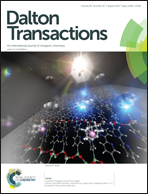Synthesis and characterization of novel niccolites [(CH3)2NH2][FeIIIMII(HCOO)6] (MII = Zn, Ni, Cu)†
Abstract
We report the synthesis, X-ray diffraction, thermal, magnetic, Raman and IR studies of three heterometallic MOFs, [(CH3)2NH2][FeIIIMII(HCOO)6] with M = Zn (DMFeZn), Ni (DMFeNi) and Cu (DMFeCu), crystallizing in the niccolite type structure. DMFeZn and DMFeNi crystallize in the trigonal structure (space group P![[3 with combining macron]](https://www.rsc.org/images/entities/char_0033_0304.gif) 1c) while DMFeCu crystallizes in the monoclinic structure (space group C2/c). Magnetic investigation shows that DMFeZn remains paramagnetic down to the lowest temperature obtained in our experiment while DMFeNi and DMFeCu exhibit ferromagnetic order below 42 and 28.5 K, respectively. IR and Raman data confirm the structural model of the monoclinic DMFeCu and show evidence for stronger hydrogen bonds when compared to trigonal DMFeZn and DMFeNi. A different hydrogen bond network in the monoclinic DMFeCu when compared to trigonal DMFeZn and DMFeNi is responsible for the different behavior of these compounds upon cooling, that is, DMFeCu exhibits a sign of short range ordering of dimethylammonium cations at low temperatures while the trigonal analogues show evolution of dynamic disorder into static disorder.
1c) while DMFeCu crystallizes in the monoclinic structure (space group C2/c). Magnetic investigation shows that DMFeZn remains paramagnetic down to the lowest temperature obtained in our experiment while DMFeNi and DMFeCu exhibit ferromagnetic order below 42 and 28.5 K, respectively. IR and Raman data confirm the structural model of the monoclinic DMFeCu and show evidence for stronger hydrogen bonds when compared to trigonal DMFeZn and DMFeNi. A different hydrogen bond network in the monoclinic DMFeCu when compared to trigonal DMFeZn and DMFeNi is responsible for the different behavior of these compounds upon cooling, that is, DMFeCu exhibits a sign of short range ordering of dimethylammonium cations at low temperatures while the trigonal analogues show evolution of dynamic disorder into static disorder.
![Graphical abstract: Synthesis and characterization of novel niccolites [(CH3)2NH2][FeIIIMII(HCOO)6] (MII = Zn, Ni, Cu)](/en/Image/Get?imageInfo.ImageType=GA&imageInfo.ImageIdentifier.ManuscriptID=C5DT01608H&imageInfo.ImageIdentifier.Year=2015)

 Please wait while we load your content...
Please wait while we load your content...